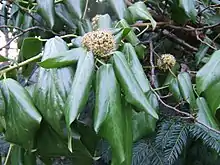Hedera colchica
Hedera colchica is a species of ivy (genus Hedera) which is native to Near and Middle East. It is commonly called Persian ivy[1] or colchis ivy.[2] It is an evergreen climbing plant, growing to 30 m high where suitable surfaces (trees, cliffs, walls) are available, and also growing as ground cover where there are no vertical surfaces. It climbs by means of aerial rootlets which cling to the substrate. In warm climates, it grows more rapidly and becomes established faster than other Hedera species.
| Hedera colchica | |
|---|---|
 | |
| Hedera colchica leaves and flowers | |
| Scientific classification | |
| Kingdom: | Plantae |
| Clade: | Tracheophytes |
| Clade: | Angiosperms |
| Clade: | Eudicots |
| Clade: | Asterids |
| Order: | Apiales |
| Family: | Araliaceae |
| Genus: | Hedera |
| Species: | H. colchica |
| Binomial name | |
| Hedera colchica | |
Description
The leaves are alternate, they are of two types, with palmately five-lobed juvenile leaves on creeping and climbing stems, and unlobed cordate adult leaves, lauroid type, on fertile flowering stems exposed to full sun, usually high in the crowns of trees or the top of rock faces. Stems are green. It has the largest leaves of any ivy to 15 cm wide and 25 cm long.
The flowers are produced from late summer until late autumn, individually small, greenish, produced in large numbers in umbels, and very rich in nectar, an important food source for bees and other insects. It flowers in September and fruits form during or after winter. The fruits are berries, globular and black when ripe. They are an important food for many birds. There are one to five seeds in each berry, which are dispersed by the birds swallowing the berries.[3]
The following cultivars have gained the Royal Horticultural Society's Award of Garden Merit:
Ecology
It is a woody evergreen climbing shrub, which can grow in a range of conditions. It prefers well-drained or alkaline soils rich in nutrients and humus with good water provision, but is extremely tough and adaptable. Like many climbing plants, it prefers its roots in cool shade with its crown in full sun. It can live over 400 years, reaching heights of 30m where suitable surfaces (trees, cliffs, walls) are available. It climbs by means of aerial rootlets with matted pads that cling strongly to the substrate. Its favoured distribution is humid microclimates, such as cloud forest, stream valleys, and the mountain ranges on the Turkish coast of the Black Sea, Asia minor, the Persian Gulf, Afghanistan, and some islands of the Red Sea.
Etymology
The ancient Latin name for Ivy.[7]
Derived from the name ‘Colchis’ or ‘Colchidis’, a Caucasian area once famous for producing poisons.[7]
References
- "Persian Ivy". BBC website.
- "Hedera colchica AGM". Royal Horticultural Society. Retrieved 2013-04-07.
- "Plant of the Week on www.davisla.wordpress.com". 24 January 2012. Retrieved 7 June 2012.
- "Hedera colchica 'Dentata' AGM". Royal Horticultural Society. Retrieved 2013-04-07.
- "Hedera colchica 'Dentata Variegata' (v) AGM". Royal Horticultural Society. Retrieved 2013-04-07.
- "Hedera colchica 'Sulphur Heart' (v) AGM". Royal Horticultural Society. Retrieved 2013-04-07.
- Gledhill, David (2008). "The Names of Plants". Cambridge University Press. ISBN 9780521866453 (hardback), ISBN 9780521685535 (paperback). pp 114, 193